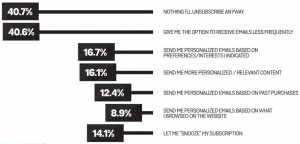Columnist Aaron Strout takes a close look at the current state of location-based marketing and predicts what we can expect to see going forward.
 Six years ago, when Wiley asked me to write a Dummies book on location-based marketing, I was equal parts thrilled and terrified. For one thing, I have several friends who are authors, and I know how much hard work goes into writing a book. For another, we were in the early days of location-based applications, and while new players were popping up every day, there really wasn’t any critical mass.
Six years ago, when Wiley asked me to write a Dummies book on location-based marketing, I was equal parts thrilled and terrified. For one thing, I have several friends who are authors, and I know how much hard work goes into writing a book. For another, we were in the early days of location-based applications, and while new players were popping up every day, there really wasn’t any critical mass.
My co-author and I also were pretty sure that things were going to change a lot over the next few years, so it was hard trying to prescribe best practices while many were still trying to predict where the market was headed.
Background
My interest in location-based applications started with a check-in/photo-tagging service called Brightkite. When it launched in 2007, it was a novel concept; it gave those of us starting to explore social media the ability to check in and find one another at events or in big cities when we were traveling.
On the heels of Brightkite came Gowalla, and then Foursquare. Whrrl, Loopt and Path also entered the scene, while the big players like Facebook, Yelp and Instagram started encouraging their members to declare their location.
While my co-author, Mike Schneider, and I were exploring all the different services, tools and brands that were experimenting with location-based services, we suspected that the “active check-in” — the need to turn on one’s smartphone, open an app, search for a location, and then decide whether or not to share that location across other social networks — would become a barrier to mass adoption of location-based services.
As Schneider and I encouraged brands testing location-based apps to provide the right incentives for customers in exchange for their information and sharing, very few actually put real skin in the game. And we saw the number of active Foursquare users in 2012 tap out at about eight million, even though the company reported north of 25 million registered users.
As we were putting the finishing touches on the book, Schneider and I foreshadowed that based on what we were seeing, the more likely path to success for location-based marketing was around passive check-ins.
We also saw a trend toward location-awareness and check-in functionality being a feature versus a service. So instead of people actively opening a mobile app and using Foursquare or Gowalla to check in, they would be more likely to add their location to a picture, update or video on a platform like Facebook, Twitter or Instagram.
So where are we now?
On the positive front, it’s several years later, and location-based marketing appears to be making another surge. This likely has to do with a few different factors.
First, we are reaching a level of wireless penetration where nearly a third of the world’s population will own a smartphone in 2017, according to Statista.
Second, 80 percent of all social media is now happening through the mobile phone. And with platforms like Facebook, Snapchat, Instagram and Twitter leading the way — all of which encourage users to geotag their posts — we have a lot more data on who is doing what, where and when.
Lastly, the amount of mobile commerce continues to rise. As such, companies like Whole Foods (disclosure: client) use geo-fences to intelligently serve up local ads to nearby customers. This led to post-click conversion rates on ads nearly three times higher than the national average, according to the company.
Looking at the current state of location-based marketing, there are four important areas that underpin it. Some have progressed more than others this year:
• Sensors: Technology like Bluetooth Low Energy beacons (Roximity, Gimbal and Estimote), sensors and microchips that allow for what is called near-field communications (NFC) between a smart device and a reader are slowly starting to scale. Cost, effort to implement and difficulty “waking up” in-store apps have slowed adoption, but efforts here continue to progress.
Samsung and Apple’s decision to include NFC chips in the last two generations of their smartphones is helping to push forward more mobile payments/proximity communications.
• Geo-fences: These virtual fences that use GPS, WiFi, electromagnetic fields or RFID technologies allow for companies to set triggers or collect data when customers/employees enter them. While not particularly expensive or difficult to set up, they do require being paired with either a mobile app with location services turned on or triggered by an event like a geo-tagged post on a platform like Facebook, Instagram or Twitter.
Major players in this space like Apple, Google and Esri, along with other industry-specific players, continue to drive this space forward.
• Context: Location-based marketing only works properly with the right context. To understand how to market to customers, you have to know where they’re coming from or going, their preferences, where they are in their shopper journey and whether or not they look like other customers.
For example, an experience near a gas station or grocery store is different from what customers would expect at home on a brand’s mobile app.
To that end, it’s also critical to map functionality to location. Ask questions about what is possible: Should customers be taking pictures? Can they connect with a customer service representative? Is it possible to help them navigate in the store? Find hidden Easter eggs? Find a review?
• Ad tech: As much as many consumers would like to see advertising go away, marketers know that it is still alive and well ($100 billion expected to be spent in mobile advertising this year).
In a recent article, I explored the different types of mobile advertising (including location-based solutions). And while many of the current solutions outside of in-app and social/mobile ads leave a lot to be desired, there is a huge opportunity for national retailers like Whole Foods to leverage location-based advertising, as mentioned earlier.
Where are we going?
I was recently at the Techonomy Summit led by David Kirkpatrick and Josh Kampel in California’s Half Moon Bay. One of the sessions was a fireside chat between Kirkpatrick and Fitbit CEO James Park. When asked about the future of Fitbit, Park was quick to reply with, “More sensors — optical, electrical and chemical.”
What excited me about hearing this is that the current sensors that exist in smartphones and fitness bracelets are mainly optical, motion and location-aware. But having more sensors that can sense temperature/climate, stress and air quality, among other things, will greatly increase the context we have as marketers.
And with more sensors comes more data — an opportunity we’re still just beginning to explore.
Another area that is about to go big is augmented reality. Right now, a majority of the augmented reality apps (think Pokémon Go) have been built to entertain versus utility (not that there is anything wrong with entertainment).
But look at the Sunshine Aquarium in Tokyo to see where the future is headed. Facing a problem of tourists not being able to easily find the aquarium after getting off the subway, the Sunshine Aquarium decided to build an app that allowed virtual penguins to show tourists the way to the aquarium. This is a killer combination of overlaid animation or data combined with location awareness.
I can envision every major retailer using smart bots and AR (augmented reality) to create personal shoppers or concierges that know the customer and can show them in-store items they know they’ll like or offer them discounts on things they know they want to buy.
Clearly, other breakthroughs in technology are on the artificial intelligence front. A continued push toward more devices being connected to the Internet of Things and smarter marketing and advertising technology will evolve this space.
While we still have a long way to go, a lot of exciting changes are going on in this space — changes that would make Brightkite’s founders’ heads spin, I’m sure.
Some opinions expressed in this article may be those of a guest author and not necessarily Marketing Land. Staff authors are listed here.
Marketing Land – Internet Marketing News, Strategies & Tips
(53)






